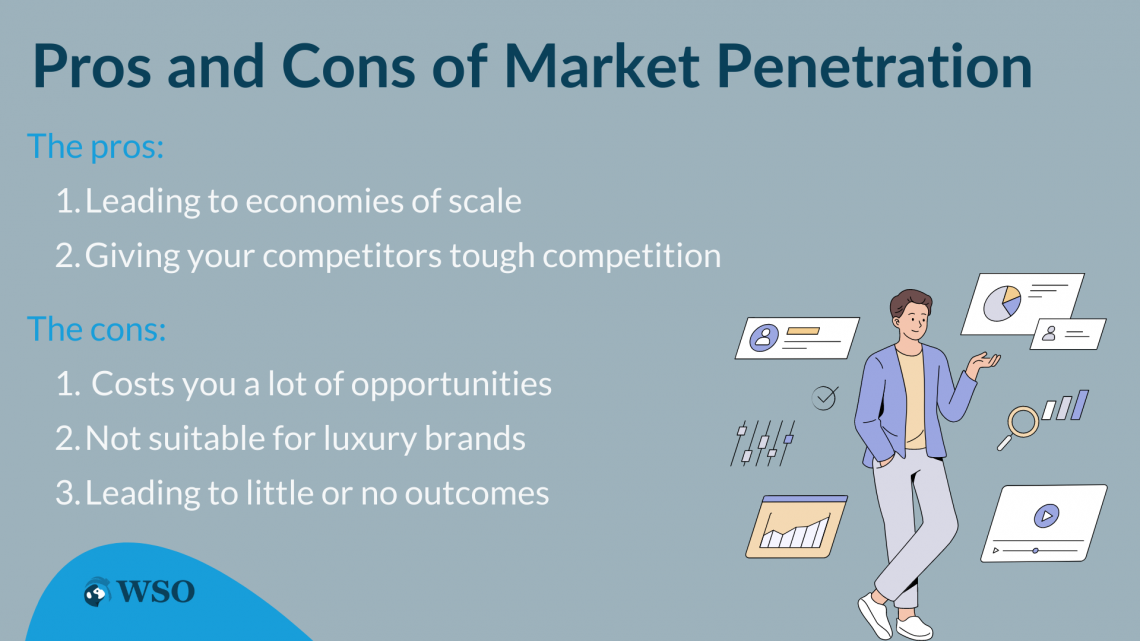Market Penetration
Market penetration is strategy focused on increasing market share for existing products in current markets.
Market penetration measures the consumption of a good or service by the final consumers as compared to the total accessible market (TAM) for that good or service.

In other words, this could be a measure to compare the actual sales of your and your competitors to know how many people consumed or purchased your products.
It can also be used to get a grasp on the market share of different players in the market, which could help other businesses or new businesses to determine their total reachable market.
For example, let us talk about the electronics industry, and to further narrow it down, let us consider laptops.
In the US, the top three major market players are HP, Dell, and Apple. The market shares of these players among 7 other major players are 35%, 27%, and 24%, respectively. This could be considered the market penetration of the respective brands.

While studying industries, this could be a great quantitative piece of equipment to assess a company's potential to increase its market share in the existing competition. It tells how much power a business holds in the industry.
In our existing example, we can say that if any other brand, other than the top 10 out of which these brands have been taken from, wants to increase its share, they need to devise strategies to outperform the ones in the top list.
Let us delve more into the understanding of this topic.
- Market penetration measures the consumption of a good or service by the final consumers as compared to the total accessible market (TAM) for that good or service.
- It is a strategy businesses use to grow their market share more than their competitors.
- The market penetration rate is the measure used to quantify a company’s performance against the total market.
- In real-life applicability, determining the total accessible market could be a tough call, especially for those brands that are spread out on a vast geographical scale.
- To attain greater market share, businesses adopt certain marketing strategies.
- Some of them are making your audience aware of the product you are offering, and innovating the products to differentiate yours from others, and many more.
What is The Market Penetration Rate and How is it Calculated?
The market penetration rate is simply a measure to quantify companies' performance against the total market. It allows the individual companies to know their current standing in the market compared to their rivals.

It is crucial for a business to know its stand in the industry and to form smart strategies to supersede other businesses and to trace their performance from time to time.
As for the calculation of the rate of penetration for a business, one should know the number of consumers captured by the business in the market and also know the total market size of the target market.
In short, the formula for market penetration is:
Market penetration rate = Number of customers / Total addressable market (TAM)
A TAM is a measure of the total available market to a business to which they can render their services or sell their products.
Make sure that the number of consumers we are considering should be existing unique customers with whom the business deals.
In this formula, some may even use only those customers who choose a particular brand over others to determine the stronger customer base. While some may find it appropriate to choose all customers who have at least once transacted with them to show a larger customer base.
In real-life applicability, determining the total accessible market could be a tough call, especially for those brands that are spread out on a vast geographical scale. People often confuse the full market size with the total population of the geographical area concerned.

It is the potential population out of the total to whom the product could appeal, and there is a possibility that they buy it.
Let us move further and find out strategies associated with market penetration that companies may implement to increase their market standing.
Strategies Related to Market Penetration
It is obvious that all the businesses in an industry strive to increase their customer base by becoming market leaders and increasing their market penetration rates. To achieve this, businesses adopt certain penetration strategies.

1. Make your audience aware of your presence
The consumers must be familiar with your product and what it has to offer.
Suppose your brand is comparatively new to the market. In that case, extensive marketing must be considered so that the market is educated about your product and services and their attention is drawn from the well-established brands to your brand.
There can be many ways to advertise your brand, such as huge banners, unique digital marketing on billboards, campaigns, pay-per-view ads on websites, etc.
2. Expand your distribution channel and simplify the buying process for customers
Distribution channels play a vital role in increasing your product’s presence in the market as much as possible.
The new business world is about thinking unconventionally and being distinct from other businesses to have the edge over them.
Businesses should think about adopting distribution channels other than conventional ones.
Nowadays, businesses are making huge sales from the online mode of distribution, making it easier and more conveniently accessible to customers. This enables the consumers to shop efficiently with all the product ranges available to them at one click.
3. Innovate the products offered
Today's times are all about thinking out of the box and constantly working on the research and development of new and advanced products/services or innovating the existing ones to make them more efficient with the help of new technological advances and other prevalent methods.
Thus, brands need to constantly work on strategies to implement innovative steps to gain more market concentration under them.
4. M&As with competitive businesses can help capture a larger segment of the market
Acquiring competitors could turn out to be a great strategic move to capture more market share as well as having a line of products to offer with more diversification, increasing the revenue streams of the business.
In such synergy moves, companies can cut back on various repetitive costs and save a lot of funds that were earlier being spent by them individually.
There are many other strategies that a business can adopt to increase its penetration rate, these are some of the most common yet most important ones to start with.
To get a real grasp on this concept, let us read a real-life case of successful penetration.
Example of A Successful Market Penetration Case
We will study Coca-Cola's market penetration strategies that helped it in becoming a home brand in the beverages and cold drinks industry.

Coca-Cola was established in 1886 by Dr. John S. Pemberton when he went on to create a soft beverage with a never-tasted flavor for its sale at a beverage point in Atlanta.
One of the amazing facts about this brand is that they have unique strategies for marketing, and they have evolved ever since.
One of the first strategies followed by it was distributing free samples through coupons which were pretty innovative back in that time! They also covered newspaper ads later on, which was common at that time, and almost everyone used to follow them.
Newspapers were so common to showcase your advertisements as, unlike today, we did not have the internet to display digital ads, and the masses used to read newspapers.
Earlier, its sale was made by pharmaceuticals as a pharmacy product, but then it transformed into a product that was available at beverage shops and stores.

Personalized advertising had made its way by the 1990s, and Coca-Cola adopted the same wherein consumers could capture their photos with a 7-feet tall Coca-Cola polar bear.
Coca-Cola went on endorsing big movie stars and musicians as well and associated them with their cold drinks and a medium to have fun, have a status in society, and a drink that would go with just about any food you have!
We can see now how Coca-Cola led itself to a home brand that, for almost the majority of us, a cold drink means a Coke!
It became a comfortable side drink you could have any time you want.
Above all, Coca-Cola's endorsement in games and sports like the soccer World Cup and Olympic athletics has made it a distinguished product by linking them to the most famous faces in sports.
The "Open Coke, open happiness" campaign helped the brand to stand out from the crowd.
We can see that Coke has always kept up with the evolving technology and innovative campaign ideas to make it the face of cold drinks, with a global market share of 43.7%. Today, cold drink means Coca-Cola!
Pros and Cons of Market Penetration
Everything comes with an advantage as well as a disadvantage. Let us look at some pros and cons of market penetration.

Let us first see some advantages linked to it.
1. Leading to economies of scale
What are economies of scale? It is the cost advantage that the firm fetches with the help of large-scale production.
When a business branches out and does mass marketing to promote its goods and services, the sales boost and they do not have to produce in a fragmented fashion but rather mass produce their products.
This increases the number of repetitive orders and helps in better supplier-side facilities.
2. Giving your competitors a tough competition
Market penetration allows you to increase your consumer base, thus leading to a larger market share to give close competition to your rivals or even supersede them in terms of market share.
Now, let us look into some of the cons of penetration which are as follows:
a. Costs you a lot of opportunities
It is one of the most common disadvantages of markets' penetration.
Selling products at lower costs than your competitors may create a wrong impression on the customers or potential consumers. People may form an opinion about the product or service that it is not of good quality.
Thus brands must keep in mind the consequences of such pricing strategies before marketing for better market share.
b. Not suitable for luxury brands
Well, this is a fact that luxurious brands should not deliberately try to increase their market share with vigorous marketing and markets' penetration strategies.
We have many examples of luxury brands that never advertise their products. Some of them are Rolls Royce, Zara, Ferrero Rocher, and Lamborghini among the top ones.
This creates an image in the mind of consumers that the brand has a social status and does not need any external aid in the form of advertising as they've established themselves as a home brand long ago already.
c. Leading to little or no outcomes
When too many brands are already trying to capture a particular niche segment to increase their marketing holding, trying to do the same could yield limited results and, above that, take up too much of your time.
However, if one researches intensively before investing funds to implement any strategies, they could turn out to be lucrative.
Market Penetration FAQ

There is nothing like only good market penetration strategy as businesses, depending on their type of products and their marketing needs, can choose any strategy that appeals best to their requirements.
Some of the common marketing strategies are promoting attempts, penetration pricing, modifications in your product, mergers, and acquisitions with rival businesses, etc.
Market growth and markets' penetration are more often than not confused with each other. However, both have the same purpose, and that is to acquire as much knowledge about your target market as possible.
Nevertheless, markets' penetration provides a number representing the portion of the target audience you have business with. At the same time, market share is the number that shows the percentage of consumers you claim out of the TAM or the total addressable market.
There is no particular number for an appropriate good penetration rate; however, according to the norms, a good penetration rate comes between 10-40% for business products.
To sum up, it depends on the type of industry the product in question is, and also on the types of products themselves.




or Want to Sign up with your social account?